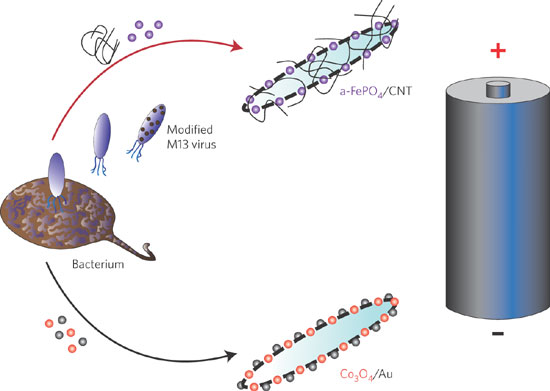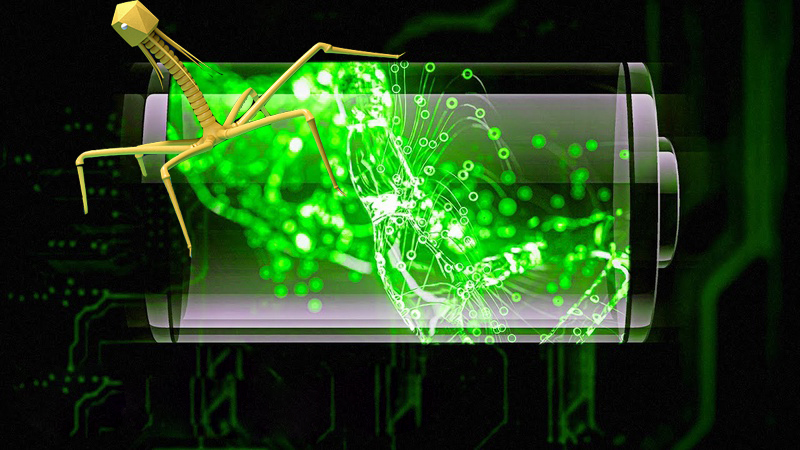Battery Technology is the seating of almost all of the tech products and now it has extended to Electric vehicles and solar power even. As years have seen increase in gadgets, EVs and other battery-equipped devices, the demand and virtue of the tech sees a surge. Scientists are under research to unfold an economical as well as efficient batteries that serve the purpose and simultaneously is safe to the environment. Like-minded, this researcher named ‘Angela Belcher’ from MIT takes the step ahead by genetically engineering viruses to produce batteries.
Virus-built Battery

In 2009, bioengineering professor Angela Belcher travelled to White House and demoed her small battery built by viruses to the then President Barack Obama. The use of viruses in the positive and negative electrodes of Lithium-ion batteries was concerned as a breakthrough tech, being a clean eco-friendly alternative to conventional toxic battery manufacturing process. That gained $2 billion in funding for the advanced battery Technology and Belcher’s virus-battery by Obama.
The start of the research
Nature has its own peculiarity and mysteries, deprived as abilities or characters of flora and fauna. The science field of biomimicry pays justice to that. Belcher too informed that her battery-research started after observing abalone shell, which is an edible mollusk of warm seas, highly structured at the nanoscale, lightweight and sturdy. Over the process of tens of millions of years, the abalone evolved so that its DNA produces proteins that extract calcium molecules from the mineral-rich aquatic environment and deposit it in ordered layers on its body. This same fundamental process could be implemented in viruses to design useful materials for humans, became the onset of her research.
Read also: Animals that inspired Technological Innovations – Biomimicry
Traditionally, batteries have two electrodes, positively charged cathode and negatively charged anode and in case of Li-ion batteries, the lithium ions flow from anode (usually graphite) to cathode (Cobalt oxide/Lithium iron phosphate). This flow of ions, if connected to an external circuit, provides an electric current, which is utilized to do work.
Make of the Virus-built battery
Now, Belcher casts M13 bacteriophage virus for her research, considering its genetic material being easy to manipulate. Belcher exposed M13 to the material she wants it to manipulate. She then extracts these viruses and instilled them into a bacterium, to pull out millions of identical copies of the virus.

Belcher nevertheless want to make viruses understand cathode or anode, but their viruses are programmed to perform a simple task. In motive to that and in reference to abalone shell, she genetically engineered the viruses to express a protein on its surface that attracts (only) cobalt oxide particles to its outer body. Additional proteins of millions of these viruses when corrugated, they accumulate more and more cobalt oxide over its body, which ultimately makes out cobalt oxide nanowire made of linked viruses, posing as a battery electrode.
This technique of engineering the DNA of viruses to attract a specific element could be a breakthrough of this field, she says. Here, in her research the virus gathered cobalt oxide, and its DNA could be tweaked to hook any other desired metal/element, in the likely way dog fanciers look for good quality breeding partner for pooch.
Increasing its Efficiency
Furthermore, research involved strengthening the cathode to pair up with anode, and molding it to be highly conductive. To achieve that, viruses are coat with iron phosphate, then grab hold of carbon nanotubes to create a network of highly conductive material. The team found that incorporating carbon nanotubes increases the cathode’s conductivity without adding too much weight to the battery. In lab tests, batteries with the new cathode material could be charged and discharged at least 100 times without losing any capacitance. That is fewer charge cycles than currently available lithium-ion batteries, but “we expect them to be able to go much longer,” Belcher said.
Advantages and Disadvantages
Following the demo to Barack Obama with her virus-built lithium-ion coin cell powering a small LED, she explained that she didn’t see much sense in competing with traditional Li-ion makers; but in answering the question “Can biology be used to solve some problems that haven’t been solved so far?”.
Creating highly ordered electrode structures, shortens the path of an ion through electrode, which would result in increase in battery’s charge and discharge rate, “a holy grail of energy storage”, says Paul Braun, director of the Materials Research Laboratory at the University of Illinois.
Check this : MIT researchers built a Wearable Device that could hack your Dreams
Nevertheless, her virus-powered batteries performed as well or better than those with electrodes made with traditional manufacturing techniques, including improved energy capacity, cycle life, and charging rates. But Belcher says the biggest benefit of viral assembly is that it is eco-friendly. Traditional electrode manufacturing techniques require working with toxic chemicals and high temperatures. All Belcher needs are the electrode materials, room temperature water, and some genetically-engineered viruses.
“Something my lab is completely focused on now is trying to get the cleanest technology,” Belcher says.
Belcher was first encountered with loads of skepticism, calling her crazy for undergoing her research. However, times had proven that her research promises to pave the way for virus-built batteries for atleast in some areas, though not a virus-powered Tesla.
References:https://www.wired.com/story/the-next-generation-of-batteries-could-be-built-by-viruses/https://news.mit.edu/2009/virus-battery-0402







Pingback: Smart Bricks – Red bricks act as power-banks, storing energy – The Inner Detail